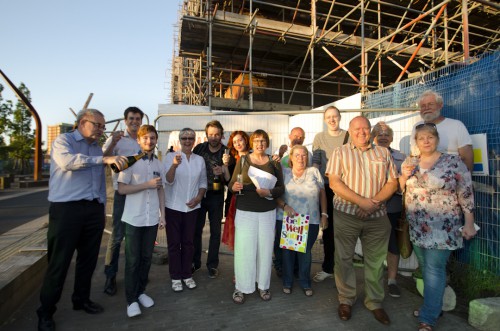The long road to saving Ancoats Dispensary
Article published: Friday, January 30th 2015
At the centre of Old Mill Street stands Ancoats Dispensary. Once the ‘beating heart’ of the community, making up one section of the historic Ancoats Hospital, the building now lies empty and abandoned. Broken windows and the absence of a roof leave it exposed to the elements, while scaffolding surrounds the crumbling facade. But a collection of placards hanging at each corner of the building displaying defiant messages – ‘Save Our Heritage’, ‘Say No to Demolition’, ‘Is this the Way to Treat a Listed Building?’ – reveals the efforts of a group of local residents and activists fighting to restore the ruined building and reunite a fragmented community.

The Ancoats Dispensary Trust began their campaign to save the Grade II listed building in 2011 after discovering that its owners, property developers Urban Splash, were planning to demolish it. The mere mention of demolition could have sounded the death knell for the dispensary if it weren’t for the efforts of the Trust. Inspired into action, a group of Ancoats residents quickly organised and established a grassroots campaign, relentlessly opposing the destruction of the iconic building.
Since then, the movement has been gaining momentum as local residents have employed a range of tactics, presenting their case to the local MP, collecting five thousand signatures of support and appearing on the BBC. The activists even held a daily vigil outside the derelict dispensary for two years, their physical presence acting as a constant reminder of the threat to the cherished building and the residents’ determination to save it. The Trust’s unwavering oppositional stance gave them a taste of victory in 2013 when Urban Splash agreed to put their plans for demolition on hold. But having successfully deferred the destruction of the building, the group are now continuing the fight to restore the dispensary and reclaim it for the Ancoats community.
The strength of feeling for the dispensary is unsurprising given its central position in the industrial heritage of Ancoats. After standing at two different locations in the area, the dispensary moved to its current position on Old Mill Street in 1874 and has been a vital part of the community ever since. As a ‘voluntary hospital’, the dispensary offered free healthcare to poor workers from the mills, foundries and factories of Ancoats. Driven by a requirement to meet the needs of an overcrowded and underprivileged industrial area, the dispensary saw innovations in the treatment of infectious diseases and physical injuries, notably opening the world’s first fracture clinic in 1914. However, the dispensary’s prominence gradually faded throughout the twentieth century, before it was eventually closed in 1989.
The Trust are now aiming to release the potential of the dormant dispensary with a plan to transform the building into a public space that can be used to promote creativity, cultural diversity and community cohesion. This renovation would potentially include art studios, meeting rooms, spaces for local social enterprise groups to operate and a community cafe. Describing themselves as a group that ‘represents a community that sees a future in the successes of their past’, it is clear that the Trust’s restoration plans deliberately draw on the institution’s history of healing. In the early twentieth century, the dispensary pioneered the treatment of broken bones. Now, the Trust are determined to reignite this reconstructive spirit to repair a community still bearing the scars of post-industrial decline.
“If you look back over the last 50 or 60 years, maybe even longer, the Ancoats area, including the hospital, was a thriving, busy community jam-packed with lots of social agencies”, recalls Linda Carver, Ancoats resident and co-ordinator of the Trust. “There was a sense that everybody was looking out for everybody else.” Changes to the community, however, caused by deindustrialisation and the demolition and relocation of housing, led to the rapid erosion of this network of social support in the second half of the twentieth century. “Nothing was happening in Ancoats. Where did people go? How did they get together and meet?”
Recent regeneration schemes, led primarily by Urban Splash, seem to have only exacerbated existing issues of disconnection in the community. “There is this feeling that there is a gentrification taking place”, says Carver, acknowledging the concern felt by local residents about the new developments, “particularly when they know that it’s almost as if no-one can get access to these apartments.” Indeed, as Urban Splash have overhauled the area with their New Islington regeneration project, the open arrangement of the council estate has largely been replaced by the imposing and isolating architecture of the luxury apartment block. It’s not hard to see why residents might feel they are being excluded.

The campaigners celebrating the first stage of the restoration outside the scaffolded dispensary.
It is unity, however, that is at the heart of the Trust’s vision and, for Carver, that includes the residents of the new flats. She envisages the restored dispensary as a catalyst for community activity, a centre around which Ancoats residents, both old and new, can converge.
By transforming the building into a space to promote the arts, Carver hopes to “challenge the perception” that recent arrivals may have of Ancoats and encourage them to engage with the area. But this focus on art and culture is also intended to inspire the existing community, as Carver emphasises the empowering potential of creative activity: “Creativity is the key to Ancoats Dispensary. The creativity that in turn creates a sense of wellbeing, which in turn creates a feeling of hope and optimism that has the power to change people’s lives.”
Highlighting the success of recent projects run at Bridge-5 Mill, 42nd Street and Hope Mill, Carver points out that the Ancoats area is seeing a resurgence of cultural and community activity, noting that the Trust hope to contribute to this increasingly cohesive network of organisations. For Carver, this transformation represents a reclamation of power for the Ancoats community after years of seeing their neighbourhood altered by private developers: “It’s about local people feeling that they are in control of things that are happening in their area, that something isn’t being imposed on them.”
With this assertion, Carver reveals the radical core of the campaign. No longer content to simply resist demolition, the group are now actively attempting to restructure the community; the Trust have progressed from a group with primarily defensive ambitions, to one that is demanding an alternative through collective grassroots action.
But the building is still not safe. Having partnered with property developers, Igloo Regeneration, the Trust have formally drawn up their restoration plan and applied for a grant from the Heritage Lottery Fund. While their initial application has been approved and the group have been awarded a provisional round of funding, the Trust still need to raise £55,000 by February in order to secure the full grant, take ownership of the building and fully realise their vision for the dispensary. The group are now engaged in a huge fundraising effort, seeking help wherever they can find it by applying for extra grants, running a recent Night of Art benefit event and holding an online crowdfunding campaign. “I’m convinced we will get it”, says Carver, who remains optimistic despite the formidable nature of the task ahead. “When people realise what they are about to lose, I think they’ll step up.”
Stressing the sense of community in the area, she adds: “People have always described it as our Ancoats, our hospital.” If the Trust can continue to gain the residents’ support in their effort to preserve their past, they will be able to reshape their future.
Michael Crick
To make a donation to save Ancoats Dispensary, please visit the website of the crowdfunding campaign: www.spacehive.com/thebeatingheartofancoats
More: Manchester, News, QuickKick
Comments
-
A magnificent effort and fine example of People Power.
Comment by A. lambs on February 17, 2015 at 11:03 am
The avaricious unprincipled desecrators Urban Trash and their grubby council associates who reside deep in the pockets of Urban Trash are defeated .
A great result . -
Wasn’t the Ancoats Dispensary founded by Dr James Philips Kay who campaigned to clear Ancoats of typhus and other diseases from the 1830s onwards? He wrote The Moral and Physical Condition of the Working Class Employed in the Cotton Manufacture in Manchester (1832) and provided Frederick Engels with a lot of the information contained in his classic work, Conditions of the Working Class in England, 1845.
Comment by Malc Cowle on February 18, 2015 at 5:39 pm
The comments are closed.



